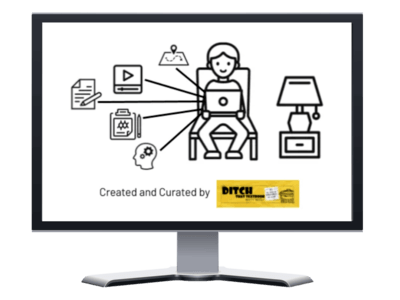
No internet at home? No problem. Set up Chromebooks and laptops with offline access to G Suite. Your elearning day activities just got a lot more interesting!
Having Chromebooks and G Suite can supercharge learning in class. Information is at students' fingertips. They can create digitally with what they learn. They can share, collaborate and make connections.
But for many students, when that Chromebook goes home, all of that changes.
Many students don't have Internet access at home. Some statistics based on U.S. census data:
- Nearly 3 million U.S. students don't have home Internet
- 17 percent of U.S. students don't have access to computers at home
- 18 percent of U.S. students don't have home access to broadband Internet
This is an especially important issue as more and more schools turn to elearning days. Students don't come to school during cancellations for weather or other reasons. They complete work from home so the school day counts and doesn't have to be made up.
Go offline to engage students in elearning day activities
Thankfully, there's an option to keep powerful digital learning on track.
Chromebooks -- and computers using the Google Chrome web browser -- can do a lot when set up to work offline. Even without a WiFi connection, users can ...
- access specified files in their Google Drive
- create new files and edit existing files in Docs, Slides, Sheets and more
- access webpages saved through a service like Pocket
- take pictures, record webcam video and screencast video with Chrome extensions that work offline
NOTE: I'm not a fan of homework. I quit giving homework as a teacher, and there's this book I co-authored about ditching it. Just want to get that out of the way. But if you feel homework must be assigned (and I can't change your mind), using offline access gives you many, many more options.
So ... how can you get your students ready to thrive with their devices at home? Let's use three steps ...

Step 1: Tech set-up
To make the most of devices with no Internet connection, there are just a few steps you'll need to take.
What your students will need
- Internet access. You have to be online to set everything up to go offline.
- The Google Chrome web browser. Chromebooks already have this. If your students don't have Chrome, it can be downloaded here.
- The Google Docs Offline Chrome extension. This will set Chrome up to work offline.
- Storage space. Google will need to save synced files to your students' devices. That's how they can access them offline.
Turn offline access on
- Open the home page for Docs, Sheets or Slides. Pick one. Doesn't matter. (Note: This is different from creating a new doc, sheet or slide presentation. Not the file ... the home page.)
- Click the three lines menu button in the top left corner. Click "Settings".
- Turn on "Offline". (Once you do this in Docs, Sheets or Slides, it's done for all of the apps. You don't have to do it again in the others, too.)
- Next time you're offline, just open Google Drive (drive.google.com) to open an existing file. Or create a new file in Docs, Slides, Sheets or Drawings with the "New" button in the top left.
This makes your most recent files available offline. If you want to make sure an older file is available offline, just open it and click "File > Make available offline."
Practice it to make sure it works! Have students turn off their WiFi in the bottom right corner of their devices. Then try to load what you want them to access offline. If it doesn't work, you can troubleshoot with them in person.
If you find that you're not able to work offline -- maybe because it's turned off by your Google admins -- here's the support page they need to enable it. (It's really quick and easy ... just turning on a feature.) Here's a Google support page about using offline access for users.
Step 2: Apps to use
There are a LOT of apps to choose from when working offline. Here are some examples:
- Google Docs, Slides, Sheets and Drawings
- Screencastify (Chrome extension) -- Record video of your screen and/or your webcam with audio. Saves to Google Drive when back online. (Or download the .webm video file to your device just to be safe.)
- Google Chrome "Save Page as .." -- Open an article to view while offline. Click the three dots in the top right corner of the screen. Choose "More tools" and "Save page as". (Or Ctrl+S.) Save the webpage on your device as a webpage file you can open offline.
- Pocket (Chrome extension) -- Save articles, news stories, blog posts and most text-based pages to be viewed offline. If you have the Google Play Store for Android apps, you can download the Pocket Android app. It will sync and download everything from your Pocket account that it can (mainly text-based items) for viewing offline.
- Awesome Screenshot (Chrome extension) -- Capture an image of your screen while offline. Draw on it, add text and more. Save it as an image file or PDF. Or record video of your screen and download it as a .webm file.
- Kami (Chrome extension) -- Annotate PDF files and documents. Download a PDF while online. Annotate while offline. (Note: I wasn't able to download the file or upload to Drive while offline. Taking screenshots of annotations to turn in later could work.)
- Camera by TurnCameraOn.com (Chrome app) -- Activates webcam to take a picture. Right-click picture (or two-finger tap) and choose to copy or save image.
- Emoji Keyboard for Google Chrome (Chrome extension) -- Copy and paste emojis into your work. Fun for creative writing and emoji poetry.
- AudioRecorder (Chrome extension) -- Record an audio file as a .wav file and save to your device.
In addition to these sites, apps and extensions, you can always download files to your device to access later. That includes PDF files, images, videos and more. They live in the downloads or files folder of your device.
Step 3: Plan lessons for elearning day activities
Now that you know what your students can do with their devices while offline, what kinds of elearning day activities can you plan with them?
Here are some ideas ...
- Have students save any of our free Google templates to Drive (and mark for offline use) to use while offline
- Many of the ideas in our free ebook -- 101 Ways to Ditch That Textbook with G Suite -- can be done with the tools students can use offline.
- Create activities where students move and drag items around a Google Slides file. Watch this video to learn how to create them. Then have students make a copy that saves offline.
- Students can create a PDF ebook with Google Slides offline.
- They can create stop motion animation with Google Slides offline.
- They can use this TikTok-inspired template and add images to it with one of the camera options above.
- Students can capture images from a science lab on their device and later create a multimedia lab report while offline. (This idea isn't just for science and can be adapted for many content areas!)
- Students can create Google Drawings mosaic art with an image they shoot with their camera offline (or an image they download while online).
- Make a Choose Your Own Adventure-style story -- or a story where students create new endings to an existing story.
- Many of the ideas from this post on using Screencastify in the classroom can be done while offline.
Engage students in memorable elearning day activities offline
Really, many of the ideas from our G Suite ideas page can be done as offline elearning day activities. Check them out and find something you like!
Remember, with any of these activities, doing a short test-run with students can help avoid problems. Have them turn WiFi off on their devices and check if an idea works before sending them home to do it.
Student work doesn't have to get boring while offline! Set up their devices to go offline and let their creative learning thrive!

Looking for more remote learning resources?
Our distance learning page has TONS of resources for bringing learning directly to your students no matter where they are!
💻 100 remote learning activities templates and tutorials
💻 Distance learning lesson planning guides and templates
💻 FREE ebooks for getting started or taking your remote teaching farther
For notifications of new Ditch That Textbook content and helpful links:
- like Ditch That Textbook on Facebook
- follow @jmattmiller on Twitter
- check out the #DitchBook community on Twitter
- follow Ditch That Textbook on Pinterest
- subscribe to the Ditch That Textbook YouTube channel!
Interested in having Matt present at your event or school? Contact him by e-mail!
Is Matt presenting near you soon? Check out his upcoming live events!


How do students submit work to teachers for feedback and evaluation if they don’t have internet access at home?
If they work on assignments while they’re at home, they would only need to find someplace with internet (library, coffee shop) to submit activities they’ve done and to access the next round of activities they need to do.
Matt,
It’s really hard for some of my teachers to get add-ons and extensions. Districts are requiring extensions to be pre-approved and limiting what they push out to students. Is the extension really needed? It seems like I can set up Drive, or an app like Docs to allow offline access to my files. If I want, I can go directly to a file and chose offline access. What am I missing?
You certainly can set up files for offline access. The extension, from what I understand, will keep recent files available offline even if they aren’t marked for offline access.